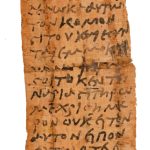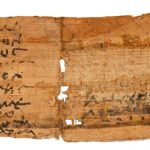| Artefact ID | 1773 |
| TM ID | TM 983377 |
| Findspot (DEChriM ID) | 8 (Umm al-Dabādīb) | Class | Textual |
| Material | Papyrus |
| Writing medium | Sheet/roll |
| Text content | Documentary |
| Language | Greek |
| Description | P. Dabadib inv. 1. Letter from Psenpnouthes to Psenpnouthes. Coincidentally, both sender and recipient are named Psenpnouthes, a Christian name whose attestations come predominantly from the Great Oasis. The author of the letter is a camel-driver (καμηλάτης), probably residing in the village of Mesobê (Μεσοβη, l. 40), in Dakhla Oasis, while the addressee seems to have been located in the Nile Valley. The sender was supposed to receive from the recipient, and through his son Psais, a kentenarion (100 Roman pounds - litrai) of iron. However, Psais did not come, and, as a result, the iron transaction did not take place. Psenpnouthes, the sender, appears to offer for the iron wheat, oil and a solidus, and to cover the cost of the transportation. The letter states the cost of the kentenarion of iron as 3 solidi. It is not entirely clear how the letter, which seemingly concerns business between Dakhla Oasis and a locality in the Nile Valley, ended at Umm al-Dabādīb. The position of the site at the intersection of caravan routes certainly explains its whereabouts. The Darb ʿAmūr, which linked Dakhla and Kharga, was one of them, and was connected to the small oasis of Umm al-Dabādīb. A Coptic graffito left on the east wall of the nave of the church of Umm al-Dabādīb (Ghica 2012: 212, n. 112; Lazaridis 2018: 242-243) attests of the circulation between this remote settlement and Dakhla. It was inscribed by a certain Anastasios, who "came from the Inner Oasis" (scil. Dakhla) and found water at Umm al-Dabādīb (aieie anima aijimoou).
|
| Selection criteria | Christian onomastics, Archaeological context associated with Christian markers |
| Date from | 353 |
| Date to | 382 |
| Dating criteria | Mention of solidus (νομισμάτιον, l. 35-36, 41-42, 46), which is "rarely mentioned in papyri before Constantius’ monetary reforms of ca. 353" (Rossi, Delattre, Bagnall 2024: 102). |
| Absolute/relative date | Relative date |
| Archaeological context | Room 2-9, on the second level of the fort of Umm al-Dabādīb. The room had been looted between 2007 and 2013, and again between 2016 and 2022. The papyri were found in May 2022, not on the floor of the room 2-9, but inside a "50-cm-thick layer of fine sand that covered the northwestern corner of the room" (Rossi, Delattre, Bagnall 2024: 94). How distrubed the layer in question was prior to the unearthing of the papyrus fragments is unclear. |
| Accession number | Egypt, Umm al-Dabādīb, P. Dabadib inv. 1. |


 Json data
Json data





